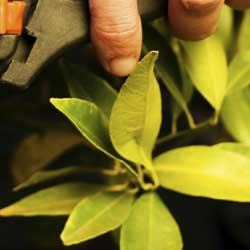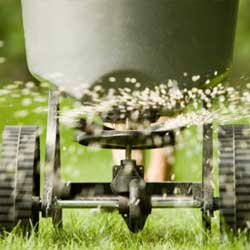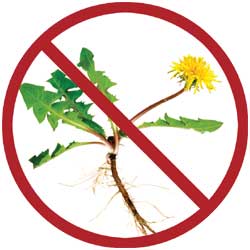Plants voluntarily grow in locations that they are well suited to. Forests develop in fertile soil and overtime the plants growing in the forest change. This is because the plants are adding and subtracting from the soil and making the conditions different, changing the group of plants that can be successful within that environment. A location that was once suited for an Aspen or a Larch will someday be home to an Oak because of these changes. Scientists can often tell the condition of a forest by the plants that are thriving. The same is true with a lawn.
We can tell the health of a soil below a lawn by the weeds that are successful in the competition for space. Weeds are defined by most as “plants out of place”. They are advantageous plants growing in locations that they are well suited for. Weeds in a lawn are a problem because they are not as effective as grass in achieving the outcomes that are desired from maintaining a lawn. Safety, erosion control, water purification, water infiltration, atmospheric carbon reduction and other environmental benefits that are the result of lawn grasses are reduced by most weeds.
The best defense against weeds is a healthy lawn, because grass can easily out-compete weeds when conditions are maintained in the grasses favor. Nutrient deficiencies, nutrient excesses, soil compaction, acidic soils, excessive shade, wet soils and many other problems can be detected by what plants are successful in infiltrating a lawn. Below is a list of some of the common names of indicator weeds (scientific name in parenthesis) that can help determine what issues are making your lawn less than perfect. Correct the problem that creates a competitive advantage for the weed and you will have an easier time getting the lawn results you are looking for.
Weeds Associated with Different Soil Problems
Acid soil: sorrel (Rumex species), sow thistle (Sonchus species), prostrate knotweed (Polygonum aviculare), lady’s-thumb (Polygonum persicaria), wild strawberries (Fragaria species), plantain (Plantago major), rough cinquefoil (Potentilla monspeliensis), silvery cinquefoil (Potentilla argentea), hawkweeds (Hieracium aurantiacum and pratense), knapweeds (Centaurea species), bentgrasses (Agrostis species)
Alkaline soil: field peppergrass (Lepidium virginicum), goosefoot (Chenopodium species), gromwell (Lithospermum officinale), true chamomile (Anthemis nobilis), bladder campion (Silene latifolia)
Wet or poorly drained soil: horsetail (Equisetum arvense), sedges (Carex species), lady’s-thumb (Polygonum persicaria), joe-pye weed (Eupatorium purpureum), silvery cinquefoil (Potentilla argentea), curly dock (Rumex crispus), mosses, Pennsylvania smartweed (Polygonum pensylvanicum), tall buttercup (Ranunculus acris), creeping buttercup (Ranunculus repens), sheep sorrel (Rumex acetosella), Canada goldenrod (Solidago canadensis), lance-leaved goldenrod (Solidago graminifolia), meadow pink (Lychnis floscuculi), jewelweed (Impatiens pallida), coltsfoot (Tussilago farfara), sweet flag (Acorus calamus), ground nut (Apios americana), annual bluegrass (Poa annua), common chickweed (Stellaria media), crabgrass (Digitaria species), goosegrass (Elusine species), ground ivy (Glechoma hederacea), mouse-ear chickweed (Cerastium vulgatum), violets (Viola species), yellow nutsedge (Cyperus esculentus)
Dry soil: Virginia pepperweed (Lepidium virginicum), rough cinquefoil (Potentilla monspeliensis), potato vine (Ipomoea pandurata), yarrow (Achillea millefolium), black medic (Medicago lupulina), red sorrel (Rumex acetosella)
Compacted or heavy soil: wild garlic (Allium vineale), dandelion (Taraxacum officinale), broadleaf dock (Rumex obtusifolius), creeping buttercup (Ranunculus repens), plantain (Plantago major), annual bluegrass (Poa annua), common chickweed (Stellaria media), goosegrass (Elusine indica), knotweed (Polygonum aviculare), mouse-ear chickweed (Cerastium vulgatum), prostrate spurge (Euphorbia supina)
Soil with a hardpan or hard crust: horse nettle (Solanum carolinense), pennycress (Thiaspi arvense), quack grass (Agropyron repens), field mustard (Brassica nigra), morning-glory (Ipomoea purpurea), pineapple weed (Matricaria sauveolens)
Previously cultivated soil: Lamb’s-quarters (Chenopodium album), plantain (several species), ragweed (Ambrosia artemisiifolia), purslane (Portulaca oleracea), dandelion (Taraxacum officinale), chickweed (Stellaria media), pigweeds (family Amaranth), carpetweed (Mollugo verticillata)
High fertility soil: chicory (Cichorium intybus), pigweeds (family Amaranth), purslane (Portulaca oleracea), dandelion (Taraxacum officinale), lamb’s-quarters (Chenopodium album), burdock (Arctium minus), pokeweed (Phytolacca americana), butter print (Abutilon theophrasti), Queen Anne’s lace (Daucus carota), annual bluegrass (Poa annua), bentgrasses (Agrostis species), Henbit (Lamium amplexicaule), yellow woodsorrel (Oxalis stricta), crabgrass (Digitaria species), mallow (Malva neglecta), purslane (Portulaca oleracea)
Low fertility soil: plantains (Plantago species), red sorrel (Rumex acetosella), white clover (Trifolium repens)
Shaded soil: annual Bluegrass (Poa annua), common chickweed (Stellaria media), ground ivy (Glechoma hederacea), mouse-ear chickweed (Cerastium vulgatum), nimblewill (Muhlenbergia shreberi), violets (Viola species)
This article was provided by and may be found, along with other helpful turf information, at www.TheLawnInstitute.org.







